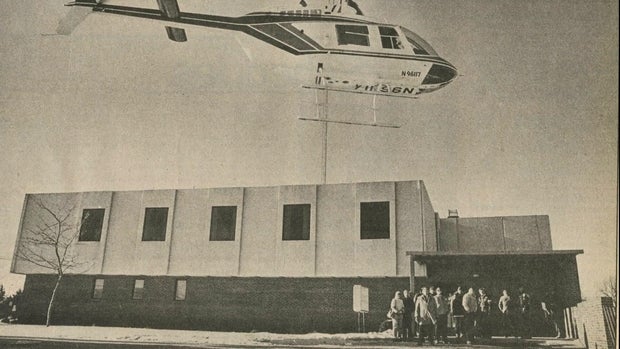Forty years ago, North Memorial Health in Robbinsdale, Minnesota, launched its AirCare program.
Today, the program has nine helicopters, 45 pilots and it airlifts about 2,600 patients a year.
One of the first to benefit from AirCare was David Olson, who was airlifted after a serious accident.
“I thought I had the strength to go over and hold the shelf up that I saw teetering. Instead, it fell and it crushed me,” he said.
Olson was 4 years old in 1985, and trying to play Superman, when heavy equipment collapsed on him at his grandpa’s shop. He was knocked unconscious, and when he woke up, the first person he saw was an AirCare nurse.
“He calmly told me that I was in a very serious accident, that I was in a helicopter and that they were bringing me to North Memorial,” he said.
Despite going into respiratory arrest with a collapsed lung, Olson recovered quickly. Forty years later, he got a chance to meet Bob Field, the flight nurse who saved him.
“When you meet someone who saved your life, it’s hard to know what to say. Thank you isn’t good enough,” Olson said.
North Memorial Health
“It’s very unusual to get someone to thank you in the way he did, especially 40 years later,” said Field, who is now retired.
The reunion prompted a trip down memory lane. Olson was one of the first AirCare patients, and Field was one of the first AirCare nurses.
“One of us sat here, one sat there, we’d be doing patient care this way,” Field said while sitting inside the helicopter’s 4-foot by 7-foot medical compartment. “I was always crouched over and I had to weigh 180 pounds. I was always dieting.”
While technology has changed over the years, little else has. When there’s an emergency call, time is of the essence.
The Leonardo helicopters can fly up to 155 mph and sometimes even faster. Field said they once reached 230 mph with a tailwind. It takes just one hour to fly from Robbinsdale to Bemidji. A drive that would take three-and-a-half hours.
In the early days of AirCare, many of the helicopters came from the Vietnam War.
“It was just hitting the civilian world and we were right there on the cusp of doing that new type of transport,” said Scott Sampey, vice president and chief of North Memorial Health Ambulance Services.
These days, they are constantly maintained and updated. For Olson, time certainly flies, and he’ll always be thankful the program launched when it did.
“That day when the shelf fell on me, I realized that I wasn’t Superman. But I also didn’t realize I would meet super men and women at North Memorial,” Olson said.
Olson said his mission now is to raise $40,000 for AirCare.
On Friday, Olson will hold a program at Chaska’s Veterans Park to recognize 40 years and to thank all emergency staff involved in treating patients.




:max_bytes(150000):strip_icc()/tal-10-cute-walking-shoes-tout-6ca39df94f7843b38e4297656fdeb1b9.jpg)
0 Comments